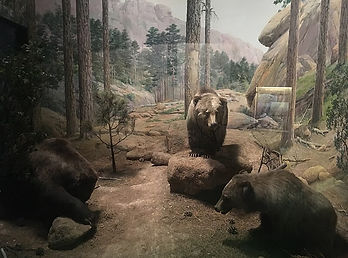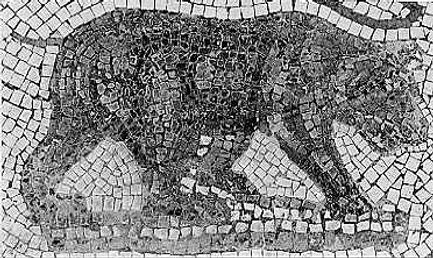Creature
Fast Facts
Introducing you to extinct species.

THE MEXICAN GRIZZLY
& ATLAS BEAR
1. The Mexican grizzly bear, Ursus arctos horribilis, was a subspecies of brown bear that roamed throughout the temperate grassland and mountainous pine forests throughout the Southwestern U.S & Mexico. Because of its warmer range, it was not believed to hibernate. 2. The Atlas bear, Ursus arctos crowtheri, was also known as the North African bear and was found in the Atlas Mountains, Morocco, and Lybia. 3. Grizzly bears are a subspecies of brown bear known as Ursus horribilis or ‘terrifying bear’. Grizzly bears have a large hump at the shoulder and golden/gray tipped fur which give them a more menacing appearance than other brown bear subspecies. Clinton Hart Merriam, a well known zoologist of his time, once theorized there were 86 forms of grizzly or brown bear in North America. 4. The Mexican grizzly was called the “pissini” by the native Opatas. The Spanish called the, “el oso plateado” meaning “the silvery bear” because they had thick yellow, gray-white- or reddish brown fur on its throat and hips, but were less furred elsewhere. 5. The Mexican grizzly were only 6 feet long and weighed up to 700 pounds making them one of the smallest grizzly bear subspecies. 6. Locals reported that ants were a favorite food of the Mexican grizzly bear. 7. The Mexican grizzly bear was hunted for sport & killed by farmers as a pest. The last one was shot in Sonora in 1976. 8. The Atlas bear was up to 9 feet long and weighed up to 1,000 pounds. It had a shorter muzzle and claws. It was more stout than other brown bear subspecies. 9. DNA testing shows that they are more closely related to polar bears or Alaska brown bears than the Middle Eastern brown bears, which are much closer geographically. 10. It liked eating acorns and was reported to eat more meat than other bears putting it into competition with the Barbary lion and Barbary leopard. 11. The Atlas bears, like other large predators, fought gladiators in the Roman coliseums. 12. The Atlas bear was hunted throughout its range especially after the invention of the firearm. The last one was shot in Morocco's Tetouan Mountains in 1870.
Extinction
Cometh
Facing the light at the end of the tunnel
EXTINCTION DATE
Atlas Bear - 1870
Mexican Grizzly - 1976
The Mexican grizzly's range may have crossed with that of the California grizzly, which is why its downfall mirrored that of the California grizzly. Spanish conquistadors like Coronado hunted grizzly when they first visited western Mexico and the Southwestern United States in 1540. Ranchers would kill grizzlies with poisoned bait balls to protect their livestock in the 1700’s. In the 1800’s, bears were captured and forced to fight bulls as a source of entertainment for the people flocking to the west coast. In the 1930’s the Mexican grizzly was considered scarce, only seen on three mountains north of Chihuahua City. By 1960, only 30 bears were left. At this time it was protected, but people continued to hunt them. In 1964, it was thought to be extinct. In 1976, one final Mexican grizzly bear was shot in Sonora. This marked the end of the Mexican grizzly. The Atlas bears met a similar fate as the Mexican and California grizzlies. It roamed more remote regions, so wasn’t as much of a nuisance animal like the North American bears. Atlas bears, Barbary lions, and Barbary leopards were forced to fight in Roman coliseums, though they were able to hide in the remote regions of the Atlas Mountains when firearms made hunting more efficient and effective, the Atlas bear population quickly declined. The Barbary lion, which shared the same range as the Atlas bear, met the same fate. The last Atlas bear was killed in Northern Morocco in 1870 in the Tetouan Mountains. Although Jurassic Park is fiction, scientists are working on several de-extinction projects. In fact, in 2003 scientists did bring back the extinct Pyrenean ibex, a type of wild goat, for 7 minutes before it died, showing de-extinction is possible. The Atlas bear and the Mexican Grizzly may be good candidates. Scientists would potentially use DNA from one of the specimens at museums. The United States has made many strides in protecting endangered species through many initiatives like the US Endangered Species Act of 1972. Since 1972, many species including the American bison, bald eagle, black-footed ferret, and grizzly bear have been saved from risk of extinction. There is currently a 10 year old debate in the state of California about whether grizzlies should be brought back into the state of California. The U.S. Fish & Wildlife Service rejected an initial petition to reintroduce the grizzly into California in 2014. Since then scientists, citizens, and California Native American tribes have created the California Grizzly Alliance to continue to push for the return of the golden bear to the Golden Coast. The debate is heated and the results are mixed about whether the state animal that flies on every California state flag would or should make a comeback into the state it once called home. If the Mexican grizzly or Atlas bear was brought back to life, would people welcome this lost apex predator back into its native homeland in Mexico or Morocco?
COMING
SOON
The Mexican grizzly and Atlas bear's Lazarus Tales have yet to be written. Would it be able to thrive again in Mexico or Morocco if it did return?
More to Explore
All answers lead to more questions

The California state flag was based on "Monarch" a female California grizzly bear that died in captivity in 1911
Image from Wikipedia
VIDEOS & ADDITIONAL INFO
Re:Wilding - Grizzlies Back to the Southwest
Lost Zoo - Mexican Grizzly Bear Facts
Last Mexican Mexican Grizzly - Video
The Last African Bear - Atlas Bear- Video
Bear Conservation Extinct California Grizzly Facts
History & Facts about Bringing Grizzlies Back to California
Wild Kratts - Bears Around the World - Video

The California state flag was based on "Monarch" a female California grizzly bear that died in captivity in 1911
Image from Wikipedia


Atlas bear image
Image from Wikimedia Commons
Atlas bears had shorter snouts
Image from extinctanimals.org

1957 Mexican grizzly killed by a hunter
Image from Inside Climate News

Painting of an Atlas bear
Image from extinctanimals.org

The California state flag was based on "Monarch" a female California grizzly bear that died in captivity in 1911
Image from Wikipedia

Ursus arctos californicus in the Santa Barbara, Natural History Museum
Image from Bear Conservation

The Brutal Bear-and-Bull Fight of the 19th Century California
Image from Atlas Obscura

A drawing of a California grizzly bear & bull fight
Image from Atlas Obscura

C. Hart Merriam's hand-colored map showing the distribution of the seven subspecies of the California Grizzly
Image from Bear Conservation

James "Grizzly" Adams trained California grizzly bears and performed with them in P.T. Barnum's circus
Image from Wikipedia

After the 1906 earthquake and fire destroyed parts of San Francisco the grizzly became a symbol of recovery
Image from Riverbank News

Educational poster Image from Bonjour Laffiche.com

A book discussing the politics involved in helping endangered species recover.
Image from University of California

Grizzly bears historic range
Image from Inside Climate News

A side-by-side comparison of a grizzly bear vs a black bear
Image from Spokesman Review

The ranges of the grizzly bear and black bear and where they overlap
Image from Geology.com

The largest grizzly bear ever recorded was shot in Alaska in 2013
Image from A-Z Animals

Teddy Roosevelt was a hunter but but also known as the "Conservation President"
Image from Inspire 99

The political cartoon by Clifford Berryman in the Washington Post on November 16, 1902 about Teddy Roosevelt's compassion during a black bear hunt in Mississippi gave rise to the 'teddy bear'
Image from National Parks Service

A replica of the original teddy bear created by Brooklyn candy shop owner Morris Michtom and his wife after seeing Berryman's political cartoon
Image from National Parks Service

Smokey Bear was a real black bear cub badly burned in a New Mexico wildfire. He was sent to the National Zoo in DC and became part of the fire prevention campaign in the U.S.
Image from Smithsonian Institute Archives

Classic Smokey Bear poster encouraging people to try to prevent wildfires
Image from American Luxury Gifts

A computer animated Smokey Bear advertising campaign
Image from PR Newswire

Wild Kratts episode contained details about the grizzly bear
Image from PBS Kids

Grizzly bears are a subspecies of brown bear
Image from Peppermint Narwhal



